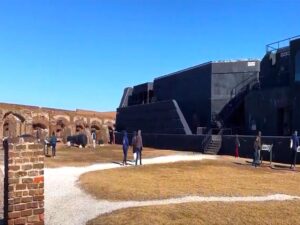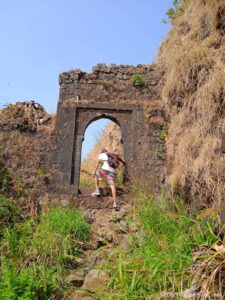Hidden within Rajasthan’s Aravalli Hills, Kumbhalgarh Fort is a magnificent representation of Rajputana’s architectural brilliance. Constructed in the 15th century by the renowned Rana Kumbha, Kumbhalgarh Fort holds a wealth of history and fascinating stories. In 2013, UNESCO recognized Kumbhalgarh Fort as a World Heritage Site, classifying it under the Hill Forts of Rajasthan group.

The remarkable feature of Kumbhalgarh Fort is its extensive wall, stretching over 36 kilometers, ranked as the world’s second-longest wall after China’s Great Wall. Snaking through the rugged terrain of the Aravali Hills, walking along it is like stepping into a different era.

The fort’s history is equally remarkable for its near invincibility, attributed to its strategic location and sturdy construction. Historically, it only succumbed once, and that was due to a critical water scarcity.
Despite its formidable walls and strategic positioning, the fort’s Achilles’ heel was its water supply. During a particularly long siege, the fort’s defenders faced a critical shortage of water, which is crucial for any sustained defense.
Without enough water to support the people inside, the fort eventually had to surrender to the Mughal Emperor Akbar and Amber forces in 1576, showcasing that even the most well-fortified structures could have vulnerabilities. Interestingly, the fort’s water conservation efforts are epitomized by Badshahi Bavdi, a stepped tank built to provide water during such crises, highlighting an architectural response to this historical weakness.

Kumbhalgarh Fort is also renowned for being the birthplace of Maharana Pratap, a celebrated Rajput warrior. This connection adds to its cultural and historical significance.
Myths and legends, particularly about its walls, envelop the fort. Legend has it that Rana Kumbha’s efforts to build the wall repeatedly failed until a spiritual advisor suggested a human sacrifice to lift a divine curse. Perhaps it was a sage himself who volunteered to help in the successful building of the wall.
Following his guidance, the first gate was built where his head landed, and today, a temple stands there, honoring his sacrifice. It’s believed the sage’s spirit still guards the fort, adding a sacred layer to its storied history.
As I previously noted, the location of Kumbhalgarh Fort amidst the Aravalli Hills sets it apart as a remarkable site. Perched high, at 1,100 meters, it offers breathtaking views, possibly even the Thar Desert, on a clear day.

Wandering through the fort, you’ll find yourself enveloped in a historical aura as if the very stones are whispering tales from the past. Just like the Nahargarh Fort in Jaipur, Kumbhalgarh Fort offers more than just its stunning architecture and rich history. It’s a place that vividly brings to life the royal heritage of Rajasthan.
Housing beautiful palaces like Kumbha Palace and Badal Mahal (Palace of the Clouds) and over 360 temples of both Jain (300) and Hindu faiths (60), the expansive fort is a sight to behold.
Perched at the fort’s highest point, with its beautiful rooms painted in pastels, Badal Mahal is the most striking structure. The palace has two interconnected sections – the Mardana (for men) and the Zanana (for women). Badal Mahal’s walls are adorned with elegant elephant paintings, and its Jhali windows add to the palace’s beauty.

Kumbha Palace, once the residence of rulers, stands less decorated and mostly in ruins compared to Badal Mahal. Yet, its historical value is remarkable.
Jhalia ka Malia, also known as the Palace of Queen Jhali, holds great significance within Kumbhalgarh Fort. It’s known as the birthplace of Maharana Pratap. This site adds an intimate touch to the fort’s majesty, drawing admirers of Maharana Pratap and history enthusiasts alike. A visit here allows one to connect with the historical legacy and courage of one of India’s iconic heroes, immersing you in the resonating legacy of the past.

Among all the temples, the Neelkanth Mahadeo Temple, with its massive Shivalinga, the Ganesh Temple, and the Vedi Temple are must-visits. Our guide shared with us an intriguing piece of lore: Rana Kumbha, known for his towering stature, was so tall (about 9 feet) that when he sat for prayers in Neelkanth Mahadeo Temple, his eyes were at the same level as the 6-foot-tall Shivling, symbolizing a profound spiritual alignment with the divine.
There are seven grand gates, known as pols, adorning the fort, and each one bears significant historical relevance. Ram Pol, Hanuman Pol, and Aret Pol stand out for their detailed craftsmanship and strategic positions.
Accessing Kumbhalgarh Fort is economical, with tickets priced at INR 40 for Indian, SAARC, and BIMSTEC nationals and INR 600 for visitors from other countries. Admission is free for children below 15 years.
You can buy tickets at Ram Pol, the primary gate. To gain deeper insight during your visit, consider hiring a government-certified guide found at the entrance.
The fort welcomes visitors from 9 am to 5 pm, Monday through Saturday. A highlight is the evening light and sound show, from 6:30 pm to 7:20 pm, which narrates the fort’s rich history in Hindi. Spending at least two hours is ideal for soaking in the full grandeur of the fort.
As for how to reach – Kumbhalgarh, nestled remotely, somewhat off the beaten path, has limited public transport options. The nearest airport is Maharana Pratap Airport in Udaipur, roughly 100 kilometers away, with Udaipur’s railway station being the closest rail link. The most practical way to get there is by taxi or a private car from Udaipur. The journey is scenic, offering a gradual shift in landscape as you near the hills.
In our adventurous spirit, we chose the less-trodden path, hiring a car with a driver for our entire Rajasthan trip. On our way to Kumbhalgarh from Udaipur, we explored the intriguing sites of Eklingji, Nathdwara, Haldighati, and the Maharana Pratap Museum. We arrived in the late evening when the fort was quieter, and fortunately, we found an expert guide for a brief but informative tour. You can alternatively book a tour well in advance.

Limited dining options near Kumbhalgarh and finding budget accommodations can be challenging. We opted to stay at the Aodhi, which eventually became a delightful experience. Other nearby accommodations include Kavish, Fateh Safari Suites, and Rawla Sagrun, offering a range of stays to suit different preferences.
PS: Imagine combining a historical trip with a bit of wildlife spotting! Yes, you can also visit the wildlife sanctuary surrounding the fort. It’s home to wolves, leopards, hyenas, plus numerous bird species.
Author Bio: Anjali from Travel Melodies

An avid traveler and writer with a keen interest in culture and history, Anjali explores the world with her family and shares these adventures on her blog, Travel Melodies. Her stories inspire families everywhere to embark on their own journeys, traveling more and creating better experiences. Follow Anjaly on Facebook and Instagram.
Other Posts You Might Like
- History of Fort Sumter
- Metropolitan Cathedral in Mexico
- Montjuic Castle, a magnificent fortress
- Visit Cadiz Cathedral in Spain
- Nothing better than a Tung Fort trek





